Abstract
OBJECTIVE--To review the health effects of tropospheric ozone and discuss the implications for public health policy. DESIGN--Literature review and consultation with scientists in Australia and overseas. Papers in English or with English language abstracts were identified by Medline search from the international peer reviewed published reports. Those from the period 1980-93 were read systematically but selected earlier papers were also considered. Reports on ozone exposures were obtained from environmental agencies in the region. RESULTS--Exposure to ozone at concentrations below the current Australian air quality goal (0.12 ppm averaged over one hour) may cause impaired respiratory function. Inflammatory changes in the small airways and respiratory symptoms result from moderate to heavy exercise in the presence of ozone at levels of 0.08-0.12 ppm. The changes in respiratory function due to ozone are short lived, vary with the duration of exposure, may be modified by levels of other pollutants (such as sulphur dioxide and particulates), and differ appreciably between individuals. Bronchial lavage studies indicate that inflammation and other pathological changes may occur in the airways before reductions in air flow are detectable, and persist after respiratory function has returned to normal. It is not known whether exposures to ozone at low levels (0.08-0.12 ppm) cause lasting damage to the lung or, if such damage does occur, whether it is functionally significant. At present, it is not possible to identify confidently population subgroups with heightened susceptibility to ozone. People with asthma may be more susceptible to the effects of ozone than the general population but the evidence is not consistent. Recent reports suggest that ozone increases airway reactivity on subsequent challenge with allergens and other irritants. Animal studies are consistent with the findings in human populations. CONCLUSION--A new one hour air quality ozone goal of 0.08 ppm for Australia, and the introduction of a four hour goal of 0.06 ppm are recommended on health grounds.
Full text
PDF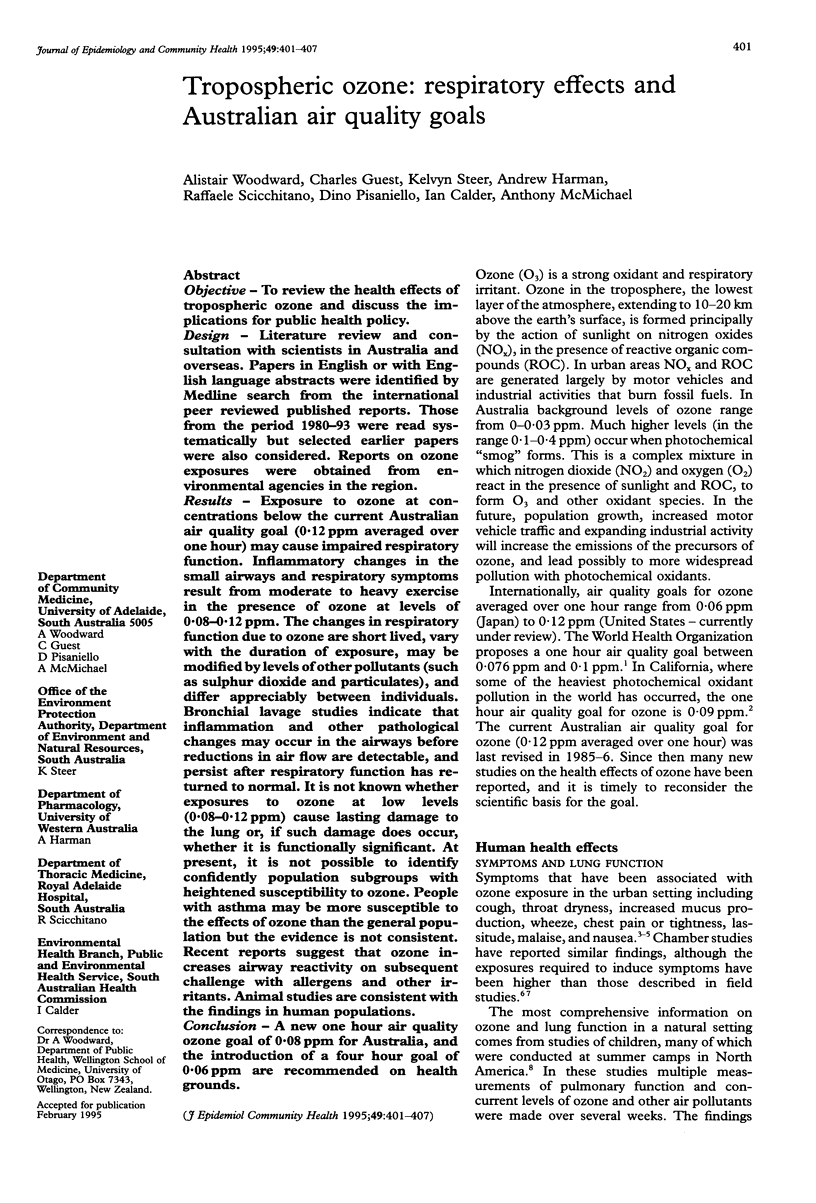
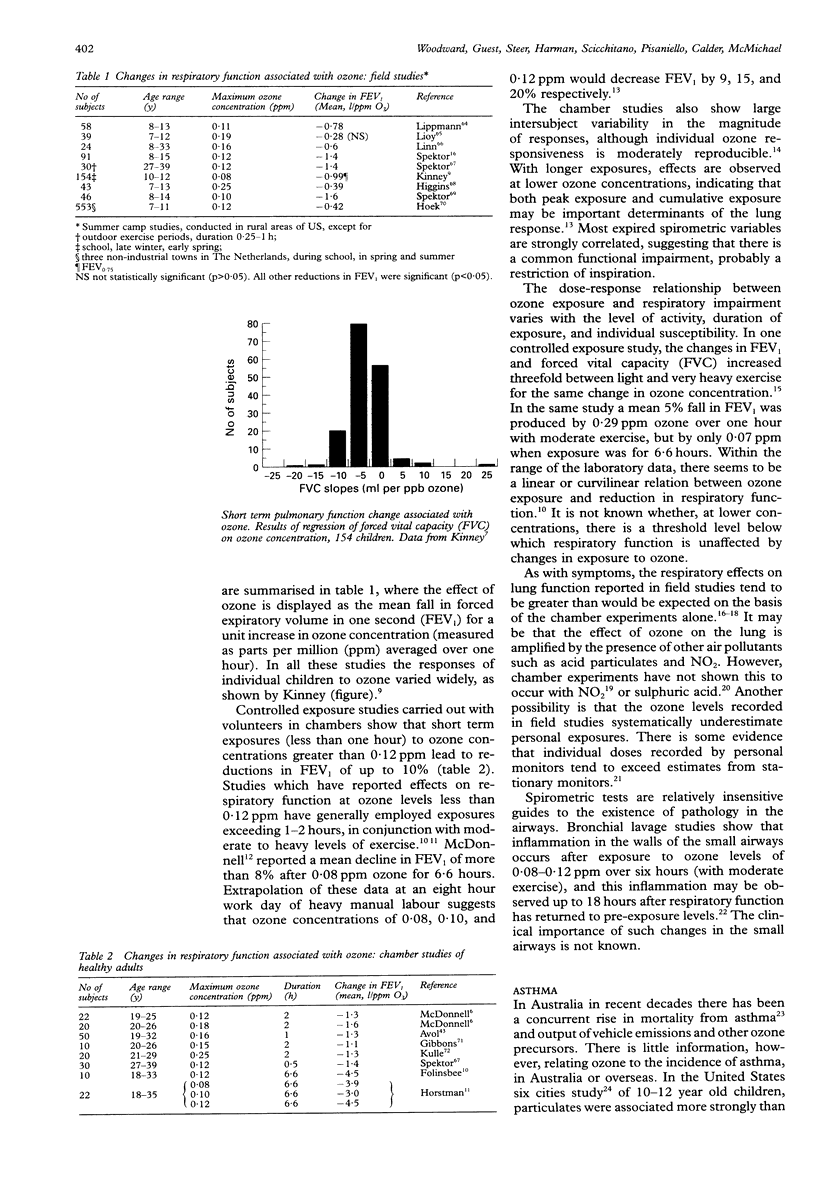
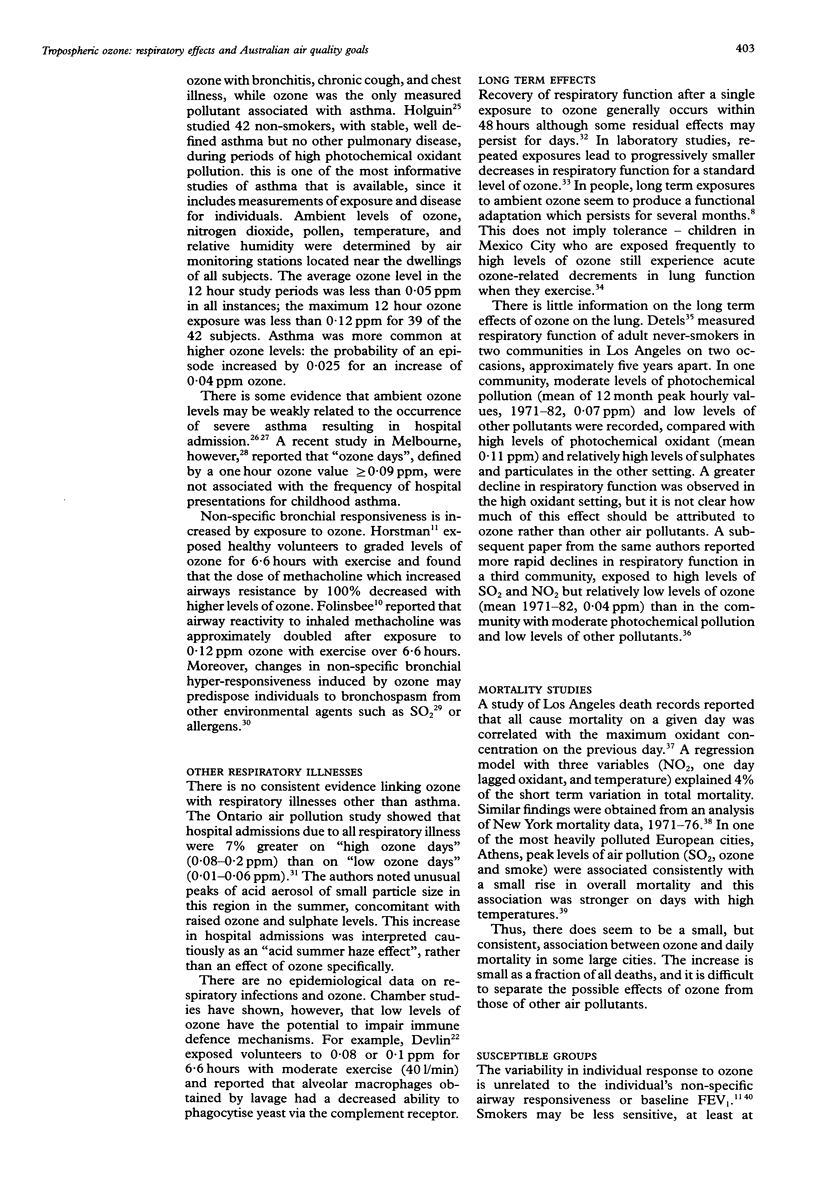
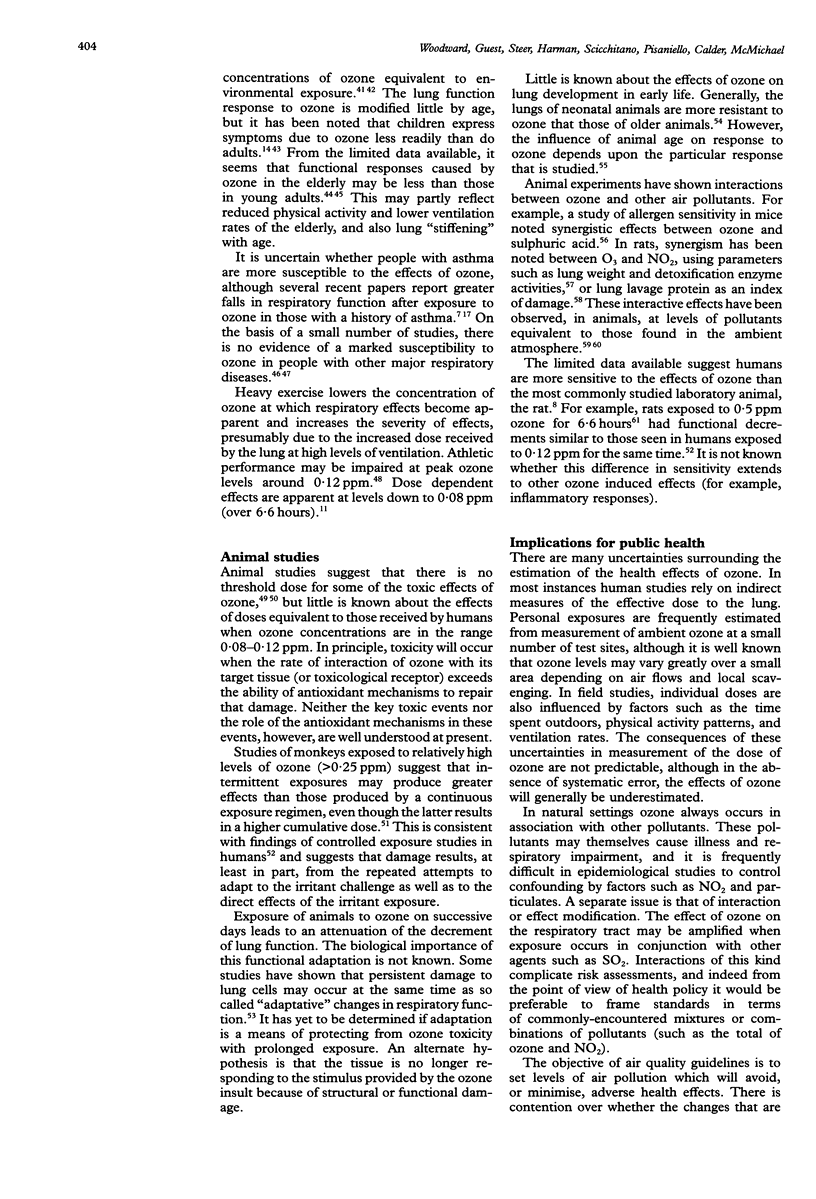
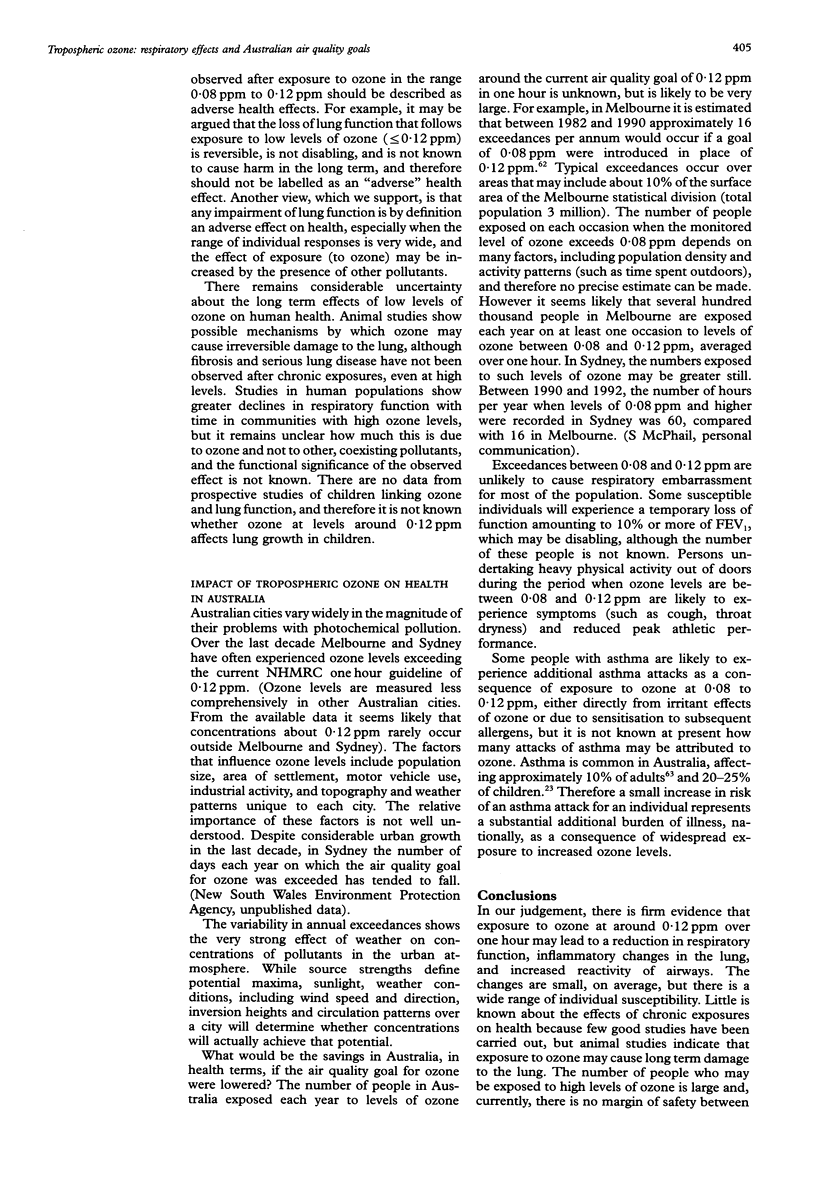
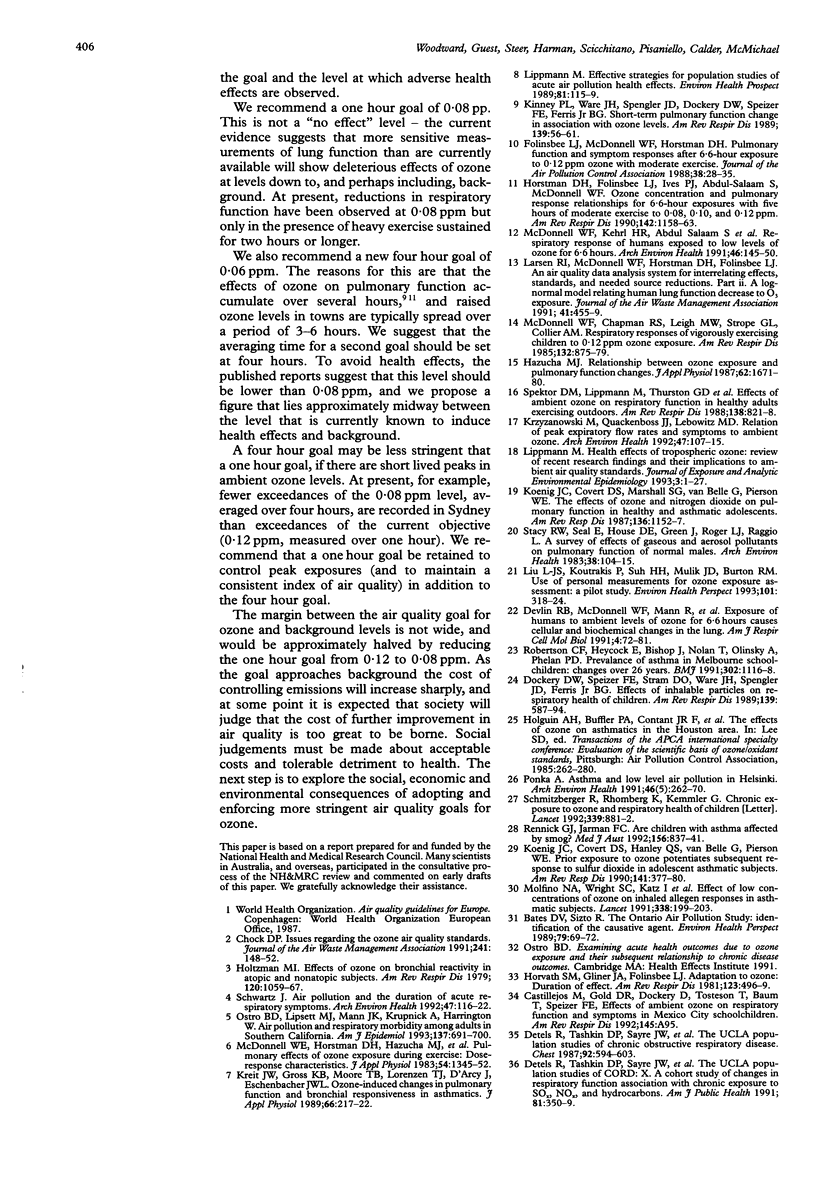
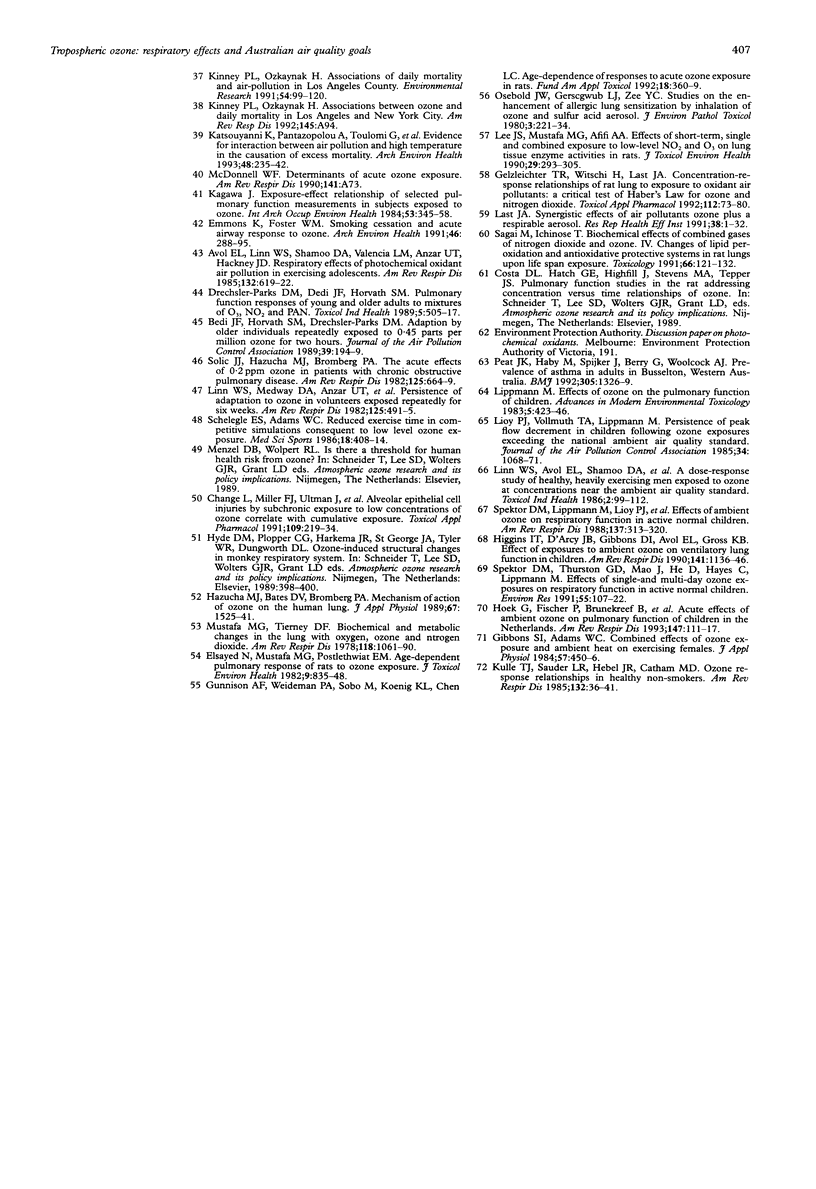
Selected References
These references are in PubMed. This may not be the complete list of references from this article.
- Avol E. L., Linn W. S., Shamoo D. A., Valencia L. M., Anzar U. T., Venet T. G., Hackney J. D. Respiratory effects of photochemical oxidant air pollution in exercising adolescents. Am Rev Respir Dis. 1985 Sep;132(3):619–622. doi: 10.1164/arrd.1985.132.3.619. [DOI] [PubMed] [Google Scholar]
- Bates D. V., Sizto R. The Ontario Air Pollution Study: identification of the causative agent. Environ Health Perspect. 1989 Feb;79:69–72. doi: 10.1289/ehp.897969. [DOI] [PMC free article] [PubMed] [Google Scholar]
- Bedi J. F., Horvath S. M., Drechsler-Parks D. M. Adaptation by older individuals repeatedly exposed to 0.45 parts per million ozone for two hours. JAPCA. 1989 Feb;39(2):194–199. doi: 10.1080/08940630.1989.10466521. [DOI] [PubMed] [Google Scholar]
- Chang L., Miller F. J., Ultman J., Huang Y., Stockstill B. L., Grose E., Graham J. A., Ospital J. J., Crapo J. D. Alveolar epithelial cell injuries by subchronic exposure to low concentrations of ozone correlate with cumulative exposure. Toxicol Appl Pharmacol. 1991 Jun 15;109(2):219–234. doi: 10.1016/0041-008x(91)90170-j. [DOI] [PubMed] [Google Scholar]
- Detels R., Tashkin D. P., Sayre J. W., Rokaw S. N., Coulson A. H., Massey F. J., Jr, Wegman D. H. The UCLA population studies of chronic obstructive respiratory disease. 9. Lung function changes associated with chronic exposure to photochemical oxidants; a cohort study among never-smokers. Chest. 1987 Oct;92(4):594–603. doi: 10.1378/chest.92.4.594. [DOI] [PubMed] [Google Scholar]
- Detels R., Tashkin D. P., Sayre J. W., Rokaw S. N., Massey F. J., Jr, Coulson A. H., Wegman D. H. The UCLA population studies of CORD: X. A cohort study of changes in respiratory function associated with chronic exposure to SOx, NOx, and hydrocarbons. Am J Public Health. 1991 Mar;81(3):350–359. doi: 10.2105/ajph.81.3.350. [DOI] [PMC free article] [PubMed] [Google Scholar]
- Devlin R. B., McDonnell W. F., Mann R., Becker S., House D. E., Schreinemachers D., Koren H. S. Exposure of humans to ambient levels of ozone for 6.6 hours causes cellular and biochemical changes in the lung. Am J Respir Cell Mol Biol. 1991 Jan;4(1):72–81. doi: 10.1165/ajrcmb/4.1.72. [DOI] [PubMed] [Google Scholar]
- Dockery D. W., Speizer F. E., Stram D. O., Ware J. H., Spengler J. D., Ferris B. G., Jr Effects of inhalable particles on respiratory health of children. Am Rev Respir Dis. 1989 Mar;139(3):587–594. doi: 10.1164/ajrccm/139.3.587. [DOI] [PubMed] [Google Scholar]
- Drechsler-Parks D. M., Bedi J. F., Horvath S. M. Pulmonary function responses of young and older adults to mixtures of O3, NO2 and PAN. Toxicol Ind Health. 1989 May;5(3):505–517. doi: 10.1177/074823378900500310. [DOI] [PubMed] [Google Scholar]
- Elsayed N. M., Mustafa M. G., Postlethwait E. M. Age-dependent pulmonary response of rats to ozone exposure. J Toxicol Environ Health. 1982 May-Jun;9(5-6):835–848. doi: 10.1080/15287398209530206. [DOI] [PubMed] [Google Scholar]
- Emmons K., Foster W. M. Smoking cessation and acute airway response to ozone. Arch Environ Health. 1991 Sep-Oct;46(5):288–295. doi: 10.1080/00039896.1991.9934389. [DOI] [PubMed] [Google Scholar]
- Folinsbee L. J., McDonnell W. F., Horstman D. H. Pulmonary function and symptom responses after 6.6-hour exposure to 0.12 ppm ozone with moderate exercise. JAPCA. 1988 Jan;38(1):28–35. doi: 10.1080/08940630.1988.10466349. [DOI] [PubMed] [Google Scholar]
- Gelzleichter T. R., Witschi H., Last J. A. Concentration-response relationships of rat lungs to exposure to oxidant air pollutants: a critical test of Haber's Law for ozone and nitrogen dioxide. Toxicol Appl Pharmacol. 1992 Jan;112(1):73–80. doi: 10.1016/0041-008x(92)90281-v. [DOI] [PubMed] [Google Scholar]
- Gibbons S. I., Adams W. C. Combined effects of ozone exposure and ambient heat on exercising females. J Appl Physiol Respir Environ Exerc Physiol. 1984 Aug;57(2):450–456. doi: 10.1152/jappl.1984.57.2.450. [DOI] [PubMed] [Google Scholar]
- Gunnison A. F., Weideman P. A., Sobo M., Koenig K. L., Chen L. C. Age-dependence of responses to acute ozone exposure in rats. Fundam Appl Toxicol. 1992 Apr;18(3):360–369. doi: 10.1016/0272-0590(92)90134-4. [DOI] [PubMed] [Google Scholar]
- Hoek G., Fischer P., Brunekreef B., Lebret E., Hofschreuder P., Mennen M. G. Acute effects of ambient ozone on pulmonary function of children in The Netherlands. Am Rev Respir Dis. 1993 Jan;147(1):111–117. doi: 10.1164/ajrccm/147.1.111. [DOI] [PubMed] [Google Scholar]
- Holtzman M. J., Cunningham J. H., Sheller J. R., Irsigler G. B., Nadel J. A., Boushey H. A. Effect of ozone on bronchial reactivity in atopic and nonatopic subjects. Am Rev Respir Dis. 1979 Nov;120(5):1059–1067. doi: 10.1164/arrd.1979.120.5.1059. [DOI] [PubMed] [Google Scholar]
- Horstman D. H., Folinsbee L. J., Ives P. J., Abdul-Salaam S., McDonnell W. F. Ozone concentration and pulmonary response relationships for 6.6-hour exposures with five hours of moderate exercise to 0.08, 0.10, and 0.12 ppm. Am Rev Respir Dis. 1990 Nov;142(5):1158–1163. doi: 10.1164/ajrccm/142.5.1158. [DOI] [PubMed] [Google Scholar]
- Horvath S. M., Gliner J. A., Folinsbee L. J. Adaptation to ozone: duration of effect. Am Rev Respir Dis. 1981 May;123(5):496–499. doi: 10.1164/arrd.1981.123.5.496. [DOI] [PubMed] [Google Scholar]
- Kagawa J. Exposure-effect relationship of selected pulmonary function measurements in subjects exposed to ozone. Int Arch Occup Environ Health. 1984;53(4):345–358. doi: 10.1007/BF00380674. [DOI] [PubMed] [Google Scholar]
- Katsouyanni K., Pantazopoulou A., Touloumi G., Tselepidaki I., Moustris K., Asimakopoulos D., Poulopoulou G., Trichopoulos D. Evidence for interaction between air pollution and high temperature in the causation of excess mortality. Arch Environ Health. 1993 Jul-Aug;48(4):235–242. doi: 10.1080/00039896.1993.9940365. [DOI] [PubMed] [Google Scholar]
- Kinney P. L., Ozkaynak H. Associations of daily mortality and air pollution in Los Angeles County. Environ Res. 1991 Apr;54(2):99–120. doi: 10.1016/s0013-9351(05)80094-5. [DOI] [PubMed] [Google Scholar]
- Kinney P. L., Ware J. H., Spengler J. D., Dockery D. W., Speizer F. E., Ferris B. G., Jr Short-term pulmonary function change in association with ozone levels. Am Rev Respir Dis. 1989 Jan;139(1):56–61. doi: 10.1164/ajrccm/139.1.56. [DOI] [PubMed] [Google Scholar]
- Koenig J. Q., Covert D. S., Hanley Q. S., van Belle G., Pierson W. E. Prior exposure to ozone potentiates subsequent response to sulfur dioxide in adolescent asthmatic subjects. Am Rev Respir Dis. 1990 Feb;141(2):377–380. doi: 10.1164/ajrccm/141.2.377. [DOI] [PubMed] [Google Scholar]
- Koenig J. Q., Covert D. S., Marshall S. G., Van Belle G., Pierson W. E. The effects of ozone and nitrogen dioxide on pulmonary function in healthy and in asthmatic adolescents. Am Rev Respir Dis. 1987 Nov;136(5):1152–1157. doi: 10.1164/ajrccm/136.5.1152. [DOI] [PubMed] [Google Scholar]
- Kreit J. W., Gross K. B., Moore T. B., Lorenzen T. J., D'Arcy J., Eschenbacher W. L. Ozone-induced changes in pulmonary function and bronchial responsiveness in asthmatics. J Appl Physiol (1985) 1989 Jan;66(1):217–222. doi: 10.1152/jappl.1989.66.1.217. [DOI] [PubMed] [Google Scholar]
- Krzyzanowski M., Quackenboss J. J., Lebowitz M. D. Relation of peak expiratory flow rates and symptoms to ambient ozone. Arch Environ Health. 1992 Mar-Apr;47(2):107–115. doi: 10.1080/00039896.1992.10118763. [DOI] [PubMed] [Google Scholar]
- Kulle T. J., Sauder L. R., Hebel J. R., Chatham M. D. Ozone response relationships in healthy nonsmokers. Am Rev Respir Dis. 1985 Jul;132(1):36–41. doi: 10.1164/arrd.1985.132.1.36. [DOI] [PubMed] [Google Scholar]
- Larsen R. I., McDonnell W. F., Horstman D. H., Folinsbee L. J. An air quality data analysis system for interrelating effects, standards, and needed source reductions: Part 11. A lognormal model relating human lung function decrease to O3 exposure. J Air Waste Manage Assoc. 1991 Apr;41(4):455–459. doi: 10.1080/10473289.1991.10466858. [DOI] [PubMed] [Google Scholar]
- Last J. A. Synergistic effects of air pollutants: ozone plus a respirable aerosol. Res Rep Health Eff Inst. 1991 Jan;(38):1–43. [PubMed] [Google Scholar]
- Lee J. S., Mustafa M. G., Afifi A. A. Effects of short-term, single and combined exposure to low-level NO2 and O3 on lung tissue enzyme activities in rats. J Toxicol Environ Health. 1990;29(3):293–305. doi: 10.1080/15287399009531392. [DOI] [PubMed] [Google Scholar]
- Linn W. S., Avol E. L., Shamoo D. A., Spier C. E., Valencia L. M., Venet T. G., Fischer D. A., Hackney J. D. A dose-response study of healthy, heavily exercising men exposed to ozone at concentrations near the ambient air quality standard. Toxicol Ind Health. 1986 Jul;2(1):99–112. doi: 10.1177/074823378600200105. [DOI] [PubMed] [Google Scholar]
- Linn W. S., Medway D. A., Anzar U. T., Valencia L. M., Spier C. E., Tsao F. S., Fischer D. A., Hackney J. D. Persistence of adaptation to ozone in volunteers exposed repeatedly for six weeks. Am Rev Respir Dis. 1982 May;125(5):491–495. doi: 10.1164/arrd.1982.125.5.491. [DOI] [PubMed] [Google Scholar]
- Lippmann M. Effective strategies for population studies of acute air pollution health effects. Environ Health Perspect. 1989 May;81:115–122. doi: 10.1289/ehp.8981115. [DOI] [PMC free article] [PubMed] [Google Scholar]
- Liu L. J., Koutrakis P., Suh H. H., Mulik J. D., Burton R. M. Use of personal measurements for ozone exposure assessment: a pilot study. Environ Health Perspect. 1993 Sep;101(4):318–324. doi: 10.1289/ehp.93101318. [DOI] [PMC free article] [PubMed] [Google Scholar]
- McDonnell W. F., 3rd, Chapman R. S., Leigh M. W., Strope G. L., Collier A. M. Respiratory responses of vigorously exercising children to 0.12 ppm ozone exposure. Am Rev Respir Dis. 1985 Oct;132(4):875–879. doi: 10.1164/arrd.1985.132.4.875. [DOI] [PubMed] [Google Scholar]
- McDonnell W. F., Horstman D. H., Hazucha M. J., Seal E., Jr, Haak E. D., Salaam S. A., House D. E. Pulmonary effects of ozone exposure during exercise: dose-response characteristics. J Appl Physiol Respir Environ Exerc Physiol. 1983 May;54(5):1345–1352. doi: 10.1152/jappl.1983.54.5.1345. [DOI] [PubMed] [Google Scholar]
- McDonnell W. F., Kehrl H. R., Abdul-Salaam S., Ives P. J., Folinsbee L. J., Devlin R. B., O'Neil J. J., Horstman D. H. Respiratory response of humans exposed to low levels of ozone for 6.6 hours. Arch Environ Health. 1991 May-Jun;46(3):145–150. doi: 10.1080/00039896.1991.9937441. [DOI] [PubMed] [Google Scholar]
- Molfino N. A., Wright S. C., Katz I., Tarlo S., Silverman F., McClean P. A., Szalai J. P., Raizenne M., Slutsky A. S., Zamel N. Effect of low concentrations of ozone on inhaled allergen responses in asthmatic subjects. Lancet. 1991 Jul 27;338(8761):199–203. doi: 10.1016/0140-6736(91)90346-q. [DOI] [PubMed] [Google Scholar]
- Mustafa M. G., Tierney D. F. Biochemical and metabolic changes in the lung with oxygen, ozone, and nitrogen dioxide toxicity. Am Rev Respir Dis. 1978 Dec;118(6):1061–1090. doi: 10.1164/arrd.1978.118.6.1061. [DOI] [PubMed] [Google Scholar]
- Osebold J. W., Gershwin L. J., Zee Y. C. Studies on the enhancement of allergic lung sensitization by inhalation of ozone and sulfuric acid aerosol. J Environ Pathol Toxicol. 1980 Jun-Jul;3(5-6):221–234. [PubMed] [Google Scholar]
- Ostro B. D., Lipsett M. J., Mann J. K., Krupnick A., Harrington W. Air pollution and respiratory morbidity among adults in southern California. Am J Epidemiol. 1993 Apr 1;137(7):691–700. doi: 10.1093/oxfordjournals.aje.a116729. [DOI] [PubMed] [Google Scholar]
- Peat J. K., Haby M., Spijker J., Berry G., Woolcock A. J. Prevalence of asthma in adults in Busselton, Western Australia. BMJ. 1992 Nov 28;305(6865):1326–1329. doi: 10.1136/bmj.305.6865.1326. [DOI] [PMC free article] [PubMed] [Google Scholar]
- Pönkä A. Asthma and low level air pollution in Helsinki. Arch Environ Health. 1991 Sep-Oct;46(5):262–270. doi: 10.1080/00039896.1991.9934386. [DOI] [PubMed] [Google Scholar]
- Rennick G. J., Jarman F. C. Are children with asthma affected by smog? Med J Aust. 1992 Jun 15;156(12):837–841. doi: 10.5694/j.1326-5377.1992.tb136995.x. [DOI] [PubMed] [Google Scholar]
- Robertson C. F., Heycock E., Bishop J., Nolan T., Olinsky A., Phelan P. D. Prevalence of asthma in Melbourne schoolchildren: changes over 26 years. BMJ. 1991 May 11;302(6785):1116–1118. doi: 10.1136/bmj.302.6785.1116. [DOI] [PMC free article] [PubMed] [Google Scholar]
- Sagai M., Ichinose T. Biochemical effects of combined gases of nitrogen dioxide and ozone. IV. Changes of lipid peroxidation and antioxidative protective systems in rat lungs upon life span exposure. Toxicology. 1991 Feb;66(2):121–132. doi: 10.1016/0300-483x(91)90213-k. [DOI] [PubMed] [Google Scholar]
- Schelegle E. S., Adams W. C. Reduced exercise time in competitive simulations consequent to low level ozone exposure. Med Sci Sports Exerc. 1986 Aug;18(4):408–414. [PubMed] [Google Scholar]
- Schmitzberger R., Rhomberg K., Kemmler G. Chronic exposure to ozone and respiratory health of children. Lancet. 1992 Apr 4;339(8797):881–882. doi: 10.1016/0140-6736(92)90333-x. [DOI] [PubMed] [Google Scholar]
- Schwartz J. Air pollution and the duration of acute respiratory symptoms. Arch Environ Health. 1992 Mar-Apr;47(2):116–122. doi: 10.1080/00039896.1992.10118764. [DOI] [PubMed] [Google Scholar]
- Solic J. J., Hazucha M. J., Bromberg P. A. The acute effects of 0.2 ppm ozone in patients with chronic obstructive pulmonary disease. Am Rev Respir Dis. 1982 Jun;125(6):664–669. doi: 10.1164/arrd.1982.125.6.664. [DOI] [PubMed] [Google Scholar]
- Spektor D. M., Lippmann M., Lioy P. J., Thurston G. D., Citak K., James D. J., Bock N., Speizer F. E., Hayes C. Effects of ambient ozone on respiratory function in active, normal children. Am Rev Respir Dis. 1988 Feb;137(2):313–320. doi: 10.1164/ajrccm/137.2.313. [DOI] [PubMed] [Google Scholar]
- Spektor D. M., Lippmann M., Thurston G. D., Lioy P. J., Stecko J., O'Connor G., Garshick E., Speizer F. E., Hayes C. Effects of ambient ozone on respiratory function in healthy adults exercising outdoors. Am Rev Respir Dis. 1988 Oct;138(4):821–828. doi: 10.1164/ajrccm/138.4.821. [DOI] [PubMed] [Google Scholar]
- Spektor D. M., Thurston G. D., Mao J., He D., Hayes C., Lippmann M. Effects of single- and multiday ozone exposures on respiratory function in active normal children. Environ Res. 1991 Aug;55(2):107–122. doi: 10.1016/s0013-9351(05)80167-7. [DOI] [PubMed] [Google Scholar]
- Stacy R. W., Seal E., Jr, House D. E., Green J., Roger L. J., Raggio L. A survey of effects of gaseous and aerosol pollutants on pulmonary function of normal males. Arch Environ Health. 1983 Mar-Apr;38(2):104–115. doi: 10.1080/00039896.1983.10543989. [DOI] [PubMed] [Google Scholar]


